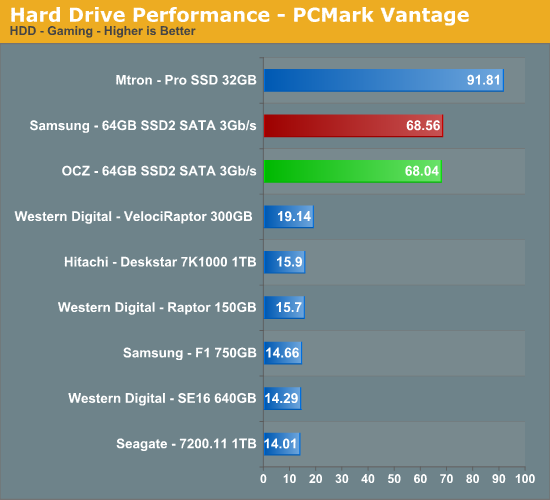64GB SSD on the Desktop: Samsung and OCZ go mainstream
by Gary Key on May 15, 2008 11:30 PM EST- Posted in
- Storage
PCMark Vantage
PCMark Vantage is the latest system benchmark available from Futuremark, and is only for use on Windows Vista. Similar to the venerable PCMark05 in its makeup, Vantage modernizes the criteria and test methodology to reflect what users may encounter when running the new Windows OS and current applications. For the HD test suite, the white paper breaks the tests down as:
- Windows Defender:
Windows Defender performs a scan operation, resulting in a read-intensive
(99.5% read, 0.5% write) benchmark reflecting a common task in Windows Vista.
- Gaming Performance:
Streaming performance is measured using actual game mechanics found in Alan
Wake. This test is nearly all read (99.95% read, 0.05% write) in nature.
- Windows Photo
Gallery: A large collection of images is imported into Windows
Photo Gallery. This is the first of the tests which bring write performance
into account in a meaningful way, with a roughly 84% read, 16% write ratio.
- Windows Vista
Startup: Simulates Windows Vista start-up operations,
producing a test that breaks down to roughly 85% read and 15% write operations.
- Windows Movie Maker:
The first of the Vantage tests which comes close to equally dividing read and
write operations (54% read, 46% write), concurrent video performance is tested
both for video read and skip performance, as well as video write operations.
- Windows Media Center:
Performing three distinct tasks:
- SDTV video playback
- SDTV video streaming to Extender for Windows Media Center
- SDTV video recording
- SDTV video playback
- Windows Media Player:
Adds music to Windows Media Player. This test reverts to favoring read
operations (78% read, 22% write).
- Application Loading:
The following applications are loaded:
- Microsoft Word 2007
- Adobe Photoshop CS2
- Internet Explorer 7
- Outlook 2007
- Microsoft Word 2007
The total benchmark is roughly 87% reads and 13% writes in nature. We run each test five times per drive, producing a median score that we use for comparison in our charts.



One advantage that SSD technology holds over mechanical drives is in access times that typically range from 0.1ms~0.3ms compared to 7.0ms~13ms on average for current mechanical drives. That alone almost ensures total dominance in benchmarks based on Intel's IPEAK program that looks at the pure speed of the drive or controller tested.










38 Comments
View All Comments
Ender17 - Friday, May 16, 2008 - link
I'm not surprised. The 334 MB platter drives are fast.Just look at this review of the Samsung F1
http://www.storagereview.com/samsungs_spinpoint_f1...">http://www.storagereview.com/samsungs_spinpoint_f1...
Beats the old ADFD Raptors across the board. And I don't know why anyone expects the Seagate drives to be fast, they're consistently at the bottom in performance.
Griswold - Friday, May 16, 2008 - link
Why? It has the same platter density.Noya - Friday, May 16, 2008 - link
Yes, and I'm using my $59 WD 640gb just for games (the first 150gb of it anyway) and the load time is very quick compared to my old 250gb 7200.8 sata.PlasmaBomb - Friday, May 16, 2008 - link
Thats probably because your old drive was nearly full and speed drops off towards the inside of the platter.semo - Saturday, May 17, 2008 - link
aren't new data stored on the inside tracks of the platter and then move outwards?Zefram0911 - Friday, May 16, 2008 - link
Is anyone disappointed in the load times for games? Only beats my old raptors by 3-5 seconds.Calin - Tuesday, May 20, 2008 - link
Load time for game levels is mostly sequential - I suppose game developers take pains in having the load level as a big sequential read (in which case solid state drives have no advantage). I am surprised about the file compression tests (which have reads and writes from different areas of the disk)retrospooty - Friday, May 16, 2008 - link
"Is anyone disappointed in the load times for games? Only beats my old raptors by 3-5 seconds."Ya, I have to wonder what the various gaming tests like "Vantage HDD Gaming" are measuring. SSD's consistantly blow HDD's out of the water scoring 300 to 500% higher on those tests (Gary's article is consistent with others I have seen)... Then real world game load and level load times are only like 5% higher.
What gives?
lemonadesoda - Wednesday, May 21, 2008 - link
It's a very easy answer: file compression. The data files (e.g. maps and textures) on disk require a lot of CPU processing before they are "ready to play".A trick used in the days of Quake engines was to unzip the .pk3 files. Then delete the .pk3. This improved load times enormously.
Perhaps game designers should have an install option to "full unzip game asset data on install". It would require a lot more HDD space. But load times would shrink.
JarredWalton - Friday, May 16, 2008 - link
It's the nature of the benchmark: access a large amount of data in a fairly random fashion and don't do ANY processing of the data, and you end up with the theoretical performance of the hard drive. That's pretty much what IPEAK-based testing accomplishes.Games have been mostly bottlenecked by CPUs, GPUs, and RAM for a long time - load times with 2GB RAM are substantially faster than with 1GB of RAM, and even 4GB of RAM can show some speedup in certain newer games. The reason for the CPU bottleneck on level loads is that most games compress data in order to conserve space; decompressing all the textures and models and such takes a fair amount of CPU power, to the point where the hard drives probably only need to sustain around 15-25MB/s.